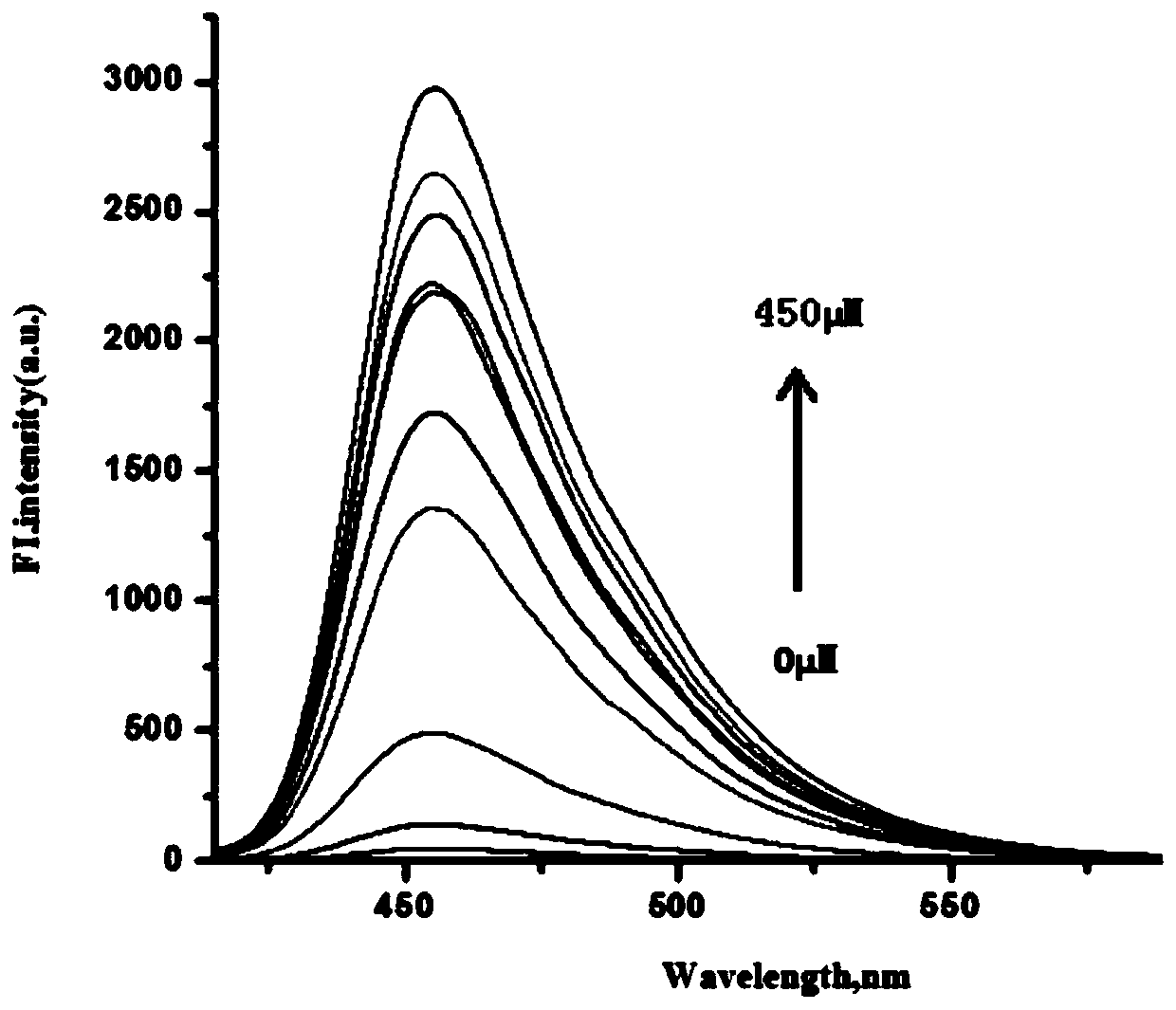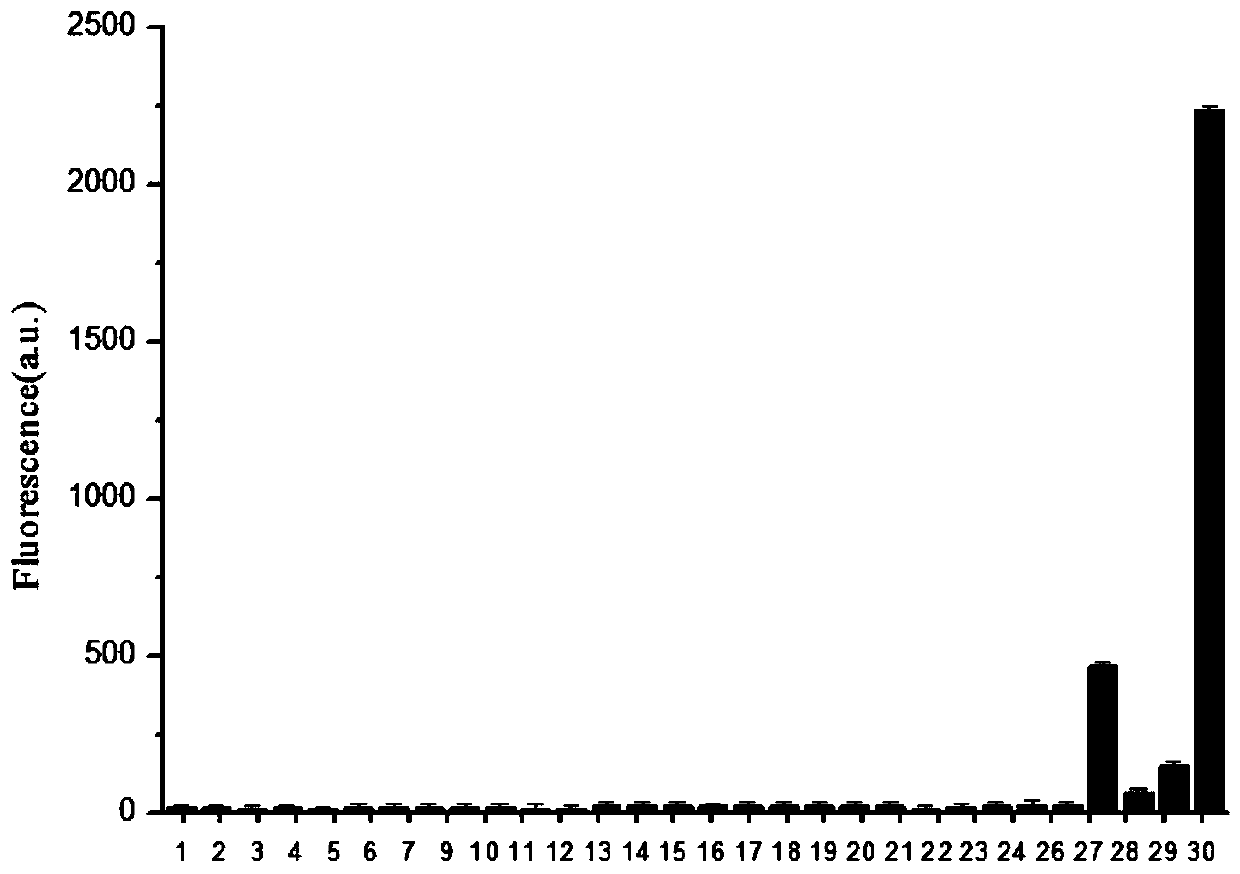Fluorescent probe for targeting detection of hydrogen sulfide in lysosome, and application thereof
A fluorescent probe, hydrogen sulfide technology, applied in the field of analytical chemistry, can solve the problems of many reaction steps, mild reaction conditions, difficult detection, etc., and achieve the effects of high specificity, low preparation cost and high sensitivity
- Summary
- Abstract
- Description
- Claims
- Application Information
AI Technical Summary
Problems solved by technology
Method used
Image
Examples
Embodiment 1
[0029] Example 1 Synthesis of Fluorescent Probes
[0030] (1) Combine coumarin-3-carboxylic acid (1 mmol), N-(2-aminoethyl)morpholine (1 mmol), 1-hydroxybenzotriazole (0.5 mmol), 1-(3- Dimethylaminopropyl)-3-ethylcarbodiimide (3 mmol), N,N-diisopropylethylamine (0.1 mL) and N,N-dimethylformamide (5 mL) were added to 25 mL one-necked flask, stirred at room temperature for 5 h. Use water-dichloromethane to carry out extraction, the compound 1 obtained after spin-drying;
[0031] (2) Compound 1 (0.6 mmol) and 2,4-dinitrobenzenesulfonyl chloride (1 mmol) were stirred in tetrahydrofuran (5 mL) at 75°C for 2.5 h, filtered with suction, and dried. The resulting solid was purified by column chromatography (dichloromethane:methanol=25:1 / v:v) to obtain a white product which was the fluorescent probe CMDN with a yield of 72%, and its HRMS spectrum was shown in figure 1 .
Embodiment 2
[0032] Example 2 Fluorescent probe pair S 2- the response to
[0033] Prepare in advance 13 5 mL portions of 10 μM probe buffer solution containing 20% DMSO. Then add Na 2 S solution, so that its concentration is 0, 10, 20, 50, 80, 100, 150, 180, 200, 250, 300, 350, 400 and 450 μM. Then perform a fluorescence scan (λ ex = 405 nm); Calculate the fluorescence intensity in each system, the scanning results are as follows figure 2 : As the concentration increases, the fluorescence peak gradually increases.
Embodiment 3
[0034] Example 3 Selectivity of fluorescent probes to different ions
[0035] Prepare 30 parts of 2 mL of 10 μM probe buffer solution (containing 20% DMSO, pH = 5), and then add 20 μL of 10 μM amino acids (Ser, Ala, Thr, Glu, Gln , Val, Asp, Leu, LLe, His, Gly and Arg), biothiols (Cys, GSH and Hcy) and other ions (NaF, NaCl, NaBr, NaI, AlCl 3 、KNO 3 , BaCl 2 , CaCl 2 、H 2 o 2 , HClO, MgCl 2 、Na 2 SO 3 and Na 2 S) etc. in PBS solution. Fluorescence detection is then performed (λ ex = 405 nm, λ em = 455 nm); calculate the fluorescence intensity in each system, and use the fluorescence intensity of the above substances as the vertical axis to make a histogram, such as image 3 Shown, where 1-30 are PBS, AlCl 3 , BaCl 2 , CaCl 2 , Ser, Ala, KCl, KI, KNO 3 , Thr, Glu, Gln, Val, Asp, Leu, LLe, His, Gly, Arg, NaF, NaCl, NaBr, NaI, MgCl 2 、Na 2 SO 3 , Cys, GSH, Hcy, Na 2 S. The results showed that the fluorescent probes for Na 2 The selectivity of S is much h...
PUM
 Login to View More
Login to View More Abstract
Description
Claims
Application Information
 Login to View More
Login to View More - R&D
- Intellectual Property
- Life Sciences
- Materials
- Tech Scout
- Unparalleled Data Quality
- Higher Quality Content
- 60% Fewer Hallucinations
Browse by: Latest US Patents, China's latest patents, Technical Efficacy Thesaurus, Application Domain, Technology Topic, Popular Technical Reports.
© 2025 PatSnap. All rights reserved.Legal|Privacy policy|Modern Slavery Act Transparency Statement|Sitemap|About US| Contact US: help@patsnap.com



